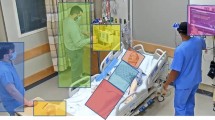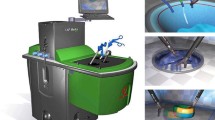Abstract
Background
Eye-gaze metrics derived from areas of interest (AOIs) have been suggested to be effective for surgical skill assessment. However, prior research is mostly based on static images and simulated tasks that may not translate to complex and dynamic surgical scenes. Therefore, eye-gaze metrics must advance to account for changes in the location of important information during a surgical procedure.
Methods
We developed a dynamic AOI generation technique based on eye gaze collected from an expert viewing surgery videos. This AOI updated as the gaze of the expert moved with changes in the surgical scene. This technique was evaluated through an experiment recruiting a total of 20 attendings and residents to view 10 videos associated with and another 10 without adverse events.
Results
Dwell time percentage (i.e., gaze duration) inside the AOI differentiated video type (U = 13508.5, p < 0.001) between videos with the presence (Mdn = 16.75) versus absence (Mdn = 19.95) of adverse events. This metric also differentiated participant group (U = 14029.5, p < 0.001) between attendings (Mdn = 15.45) and residents (Mdn = 19.80). This indicates that our dynamic AOIs reflecting the expert eye gaze was able to differentiate expertise, and the presence of unexpected adverse events.
Conclusion
This dynamic AOI generation technique produced dynamic AOIs for deriving eye-gaze metrics that were sensitive to expertise level and event characteristics.




Similar content being viewed by others
References
von Strauss und Torney M, Dell-Kuster S, Mechera R, Rosenthal R, Langer I (2012) The cost of surgical training: analysis of operative time for laparoscopic cholecystectomy. Surg Endosc 26(9):2579–2586. https://doi.org/10.1007/s00464-012-2236-1
Williams TE Jr, Satiani B, Thomas A, Ellison EC (2009) The impending shortage and the estimated cost of training the future surgical workforce. Ann Surg 250(4):590–597
Fraher EP, Knapton A, Sheldon GF, Meyer A, Ricketts TC (2013) Projecting surgeon supply using a dynamic model. Ann Surg 257(5):867–872
Sheldon GF (2007) Surgical workforce since the 1975 study of surgical services in the United States: an update. Ann Surg 246(4):541–545
Khan RSA, Tien G, Atkins MS, Zheng B, Panton ONM, Meneghetti AT (2012) Analysis of eye gaze: do novice surgeons look at the same location as expert surgeons during a laparoscopic operation? Surg Endosc 26(12):3536–3540. https://doi.org/10.1007/s00464-012-2400-7
Wilson M, McGrath J, Vine S, Brewer J, Defriend D, Masters R (2010) Psychomotor control in a virtual laparoscopic surgery training environment: gaze control parameters differentiate novices from experts. Surg Endosc 24(10):2458–2464. https://doi.org/10.1007/s00464-010-0986-1
Tien T, Pucher PH, Sodergren MH, Sriskandarajah K, Yang G-Z, Darzi A (2014) Eye tracking for skills assessment and training: a systematic review. J Surg Res 191(1):169–178. https://doi.org/10.1016/j.jss.2014.04.032
Gegenfurtner A, Siewiorek A, Lehtinen E, Säljö R (2013) Assessing the quality of expertise differences in the comprehension of medical visualizations. Vocat Learn 6(1):37–54. https://doi.org/10.1007/s12186-012-9088-7
Wilson MR, Vine SJ, Bright E, Masters RSW, Defriend D, McGrath JS (2011) Gaze training enhances laparoscopic technical skill acquisition and multi-tasking performance: a randomized, controlled study. Surg Endosc 25(12):3731–3739. https://doi.org/10.1007/s00464-011-1802-2
Vine SJ, Masters RSW, McGrath JS, Bright E, Wilson MR (2012) Cheating experience: guiding novices to adopt the gaze strategies of experts expedites the learning of technical laparoscopic skills. Surgery 152(1):32–40. https://doi.org/10.1016/j.surg.2012.02.002
Sodergren MH, Orihuela-Espina F, Froghi F, Clark J, Teare J, Yang GZ, Darzi A (2011) Value of orientation training in laparoscopic cholecystectomy. BJS 98(10):1437–1445. https://doi.org/10.1002/bjs.7546
Hermens F, Flin R, Ahmed I (2013) Eye movements in surgery: a literature review. J Eye Mov Res 6(4):1–11
Holmqvist K, Nystrom M, Andersson R, Dewhurst R, Jarodzka H, van de Weijer J (2011) Eye tracking: a comprehensive guide to methods and measures. Oxford University Press, Oxford, New York
Goldberg JH, Helfman JI (2010) Comparing information graphics: a critical look at eye tracking. Paper presented at the proceedings of the 3rd BELIV’10 workshop: BEyond time and errors: novel evaLuation methods for Information Visualization, Atlanta, Georgia
Sodergren MH, Orihuela-Espina F, Mountney P, Clark J, Teare J, Darzi A, Yang G-Z (2011) Orientation strategies in natural orifice translumenal endoscopic surgery. Ann Surg 254(2):257–266
Eivazi S, Bednarik R, Tukiainen M, Fraunberg Mvuz, Leinonen V, Jääskeläinen JE (2012) Gaze behaviour of expert and novice microneurosurgeons differs during observations of tumor removal recordings. Paper presented at the proceedings of the symposium on eye tracking research and applications, Santa Barbara, California
Wilson MR, McGrath JS, Vine SJ, Brewer J, Defriend D, Masters RSW (2011) Perceptual impairment and psychomotor control in virtual laparoscopic surgery. Surg Endosc 25(7):2268–2274. https://doi.org/10.1007/s00464-010-1546-4
Ahmidi N, Ishii M, Fichtinger G, Gallia Gary L, Hager Gregory D (2012) An objective and automated method for assessing surgical skill in endoscopic sinus surgery using eye-tracking and tool-motion data. Int Forum Allergy Rhinol 2(6):507–515. https://doi.org/10.1002/alr.21053
Richstone L, Schwartz MJ, Seideman C, Cadeddu J, Marshall S, Kavoussi LR (2010) Eye metrics as an objective assessment of surgical skill. Ann Surg 252(1):177–182
Hessels RS, Kemner C, van den Boomen C, Hooge ITC (2016) The area-of-interest problem in eyetracking research: a noise-robust solution for face and sparse stimuli. Behav Res Methods 48(4):1694–1712. https://doi.org/10.3758/s13428-015-0676-y
Tien G, Atkins MS, Zheng B (2012) Measuring gaze overlap on videos between multiple observers. In: Proceedings of the symposium on eye tracking research and applications. ACM, Santa Barbara, CA, pp 309–312. https://doi.org/10.1145/2168556.2168623
Gegenfurtner A, Lehtinen E, Säljö R (2011) Expertise differences in the comprehension of visualizations: a meta-analysis of eye-tracking research in professional domains. Educ Psychol Rev 23(4):523–552. https://doi.org/10.1007/s10648-011-9174-7
Orquin JL, Ashby NJS, Clarke ADF (2015) Areas of interest as a signal detection problem in behavioral eye-tracking research. J Behav Decis Mak 29(2–3):103–115. https://doi.org/10.1002/bdm.1867
Di Stasi LL, Diaz-Piedra C, Rieiro H, Sánchez Carrión JM, Martin Berrido M, Olivares G, Catena A (2016) Gaze entropy reflects surgical task load. Surg Endosc 30(11):5034–5043. https://doi.org/10.1007/s00464-016-4851-8
Law B, Atkins MS, Kirkpatrick AE, Lomax AJ (2004) Eye gaze patterns differentiate novice and experts in a virtual laparoscopic surgery training environment. Paper presented at the proceedings of the 2004 symposium on eye tracking research & applications, San Antonio, Texas
Kasarskis P, Stehwien J, Hickox J, Aretz A, Wickens CD (2001) Comparison of expert and novice scan behaviors during VFR flight. In: 11th international symposium on aviation psychology. The Ohio State University, Columbus, OH
Kundel HL, Nodine CF, Conant EF, Weinstein SP (2007) Holistic component of image perception in mammogram interpretation: gaze-tracking study. Radiology 242(2):396–402. https://doi.org/10.1148/radiol.2422051997
Atkins SM, Jiang X, Tien G, Zheng B (2012) Saccadic delays on targets while watching videos. In: Association for computing machinery. Santa Barbara, CA, pp 405–408
Acknowledgements
We are grateful to all the attendings and residents who volunteered to participate in this study.
Funding
This research was supported through a Center for Excellence in Surgical Education, Research and Training (CESERT) Grant of the Association for Surgical Education (#16-01), and a Research Acceleration Program Grant of Carilion Clinic (#65111).
Author information
Authors and Affiliations
Corresponding author
Ethics declarations
Disclosures
Eric Fichtel, Nathan Lau, Sarah Hendrickson Parker, Siddarth Ponnala, Juyeon Park, Shimae Fitzgibbons, and Shawn D. Safford have no conflicts of interest or financial ties to disclose.
Rights and permissions
About this article
Cite this article
Fichtel, E., Lau, N., Park, J. et al. Eye tracking in surgical education: gaze-based dynamic area of interest can discriminate adverse events and expertise. Surg Endosc 33, 2249–2256 (2019). https://doi.org/10.1007/s00464-018-6513-5
Received:
Accepted:
Published:
Issue Date:
DOI: https://doi.org/10.1007/s00464-018-6513-5




